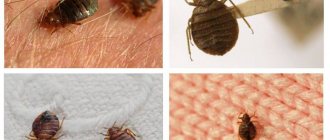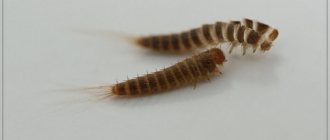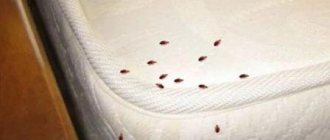- By Vil Malinoshevsky
- About bedbugs
Probably every third of our clients asks on the phone whether bedbugs bite pets - cats or dogs. And we have long found out that most often people ask this question not so much out of concern for their pets, but in an attempt to find out some other questions that they either cannot or are embarrassed to voice.
If a cat is constantly itching, then it is almost certainly being bitten by fleas, but not bedbugs.
Let's look at this issue.
Do bed bugs bite your beloved cats and dogs?
There are many options for exterminating blood-sucking creatures, depending on the degree of infestation of apartments. For houses with dogs and cats, disinsection is most often used, which requires about 4-6 hours of keeping the pet away from the place of residence. A severe case of insect sanitation would require the entire family to be away from home for three days.
They also emphasized that some pets, such as birds and reptiles, may have varying sensitivities to environmental pesticides, so it's important to make sure the treatment you choose is safe for your specific pet.
How to remove bedbugs from a cat or dog
It takes very little for your home to become infested with bed bugs. They thrive in hard-to-reach places, making them difficult to eradicate.
As a rule, the best results are achieved when the destruction is carried out by a specialist. The first step is to determine where the bed bugs are. The bedroom is their most common habitat. Bed bugs are also common in living rooms. Infestations can start in one room and move to others over time.
Seventy percent of infestations are located around beds, so much of the eradication process is aimed at clearing these areas.
Bed linens are washed in hot water, mattresses are encased in insect-proof covers, and bed frames are treated with both a vacuum cleaner to remove large adults and nymphs and chemicals to kill eggs.
If bed bugs are found in other areas, such as dressers, the same process is repeated there.
There are many different products available to eliminate bed bugs. It is very important to read both the label and the safety data sheet of the product for little brothers. None of the products should be applied directly to the pets themselves.
Can bedbugs bite cats and dogs?
Bed bugs can bite people or pets, or even wild animals that sneak into abandoned homes (though this is not as common for obvious reasons). This is why bed bug infestations in uninhabited homes can continue for so long, even though no one is around.
The only problem is that bed bugs don't like fur or hair. It's much harder for them to bite your pet than it is for them to bite you.
Do cats and dogs attract bed bugs?
Bed bugs are attracted to two main lures: body heat and carbon dioxide. By following them, bloodsuckers can easily find their way to the owner. Humans, cats, dogs of any breed, and other pets are warm-blooded and breathe, so bed bugs can find your furries just as easily as they can find you.
However, cats and dogs cannot attract bed bugs unless there is already an infestation nearby. A bedbug infestation doesn't just come out of nowhere. Bed bugs can usually find a new host within six feet, but they may explore around in an attempt to find someone.
So if your neighbor has bed bugs, a cat can help lure them away. But if no one around has bed bugs, there's no way to attract them.
Where do bedbugs bite cats and dogs?
Bed bugs prefer to bite areas that don't have a lot of fur or hair. That's why when you wake up with bed bug bites, they're more likely to be on your back or legs than on your head.
When it comes to biting pets, bed bugs will choose areas where they have easier access to the skin. They cannot dig into the fur, they will choose more open areas such as:
- Stomach
- Ears
- Parts of their feet
Check your cat or dog to see where they have less fur and if they have bites there if you think they have suffered from bed bugs. Cats and dogs with thicker or longer fur are at lower risk because there is less room for bed bugs to bite. To be sure that the poor animal has suffered from bedbugs, look at what bites look like on the Internet.
Danger to poultry
Not only animals, but also birds can be at risk from bedbugs. Chickens are especially often at risk. Insect saliva, injected under the skin during a bite, causes severe itching in poultry. But the main danger is that infections can get in with saliva.
Night bites of parasites lead to birds beginning to behave restlessly and stop laying eggs. Chickens that have been bitten usually look very scared, fuss, and do not stand still. Over time, the natural shine of the feathers disappears, they no longer lie smoothly, they are ruffled. There are times when chickens begin to lose plumage and body weight. This is explained by the fact that young birds due to this situation develop anemia, which can lead to the death of the chicken. Parasite bites also cause inflammation of the mucous membranes. When a brood hen is attacked by bedbugs, she may leave behind a clutch of eggs. This can also happen at a later date.
In addition to chickens, parasites pose a danger to other poultry. The exception is waterfowl. They have dense plumage and thick skin.
Where to look for bedbugs in a chicken coop
If bedbug bites are found on domestic chickens, then immediate action must be taken. First, you need to determine the habitat of the parasites. It is worth considering that bedbugs are quite tenacious insects, and if the chicken coop has been empty for a long time, this does not mean that the parasites have disappeared.
Where is the first place to look for dangerous insects? Bedbugs often hide in secluded places: chicken nests, cracks, joints, various wooden fastenings. You can also find parasites under bird droppings, which retain heat and moisture well, thereby creating ideal conditions for the existence of bedbugs.
In chicken coops, insects are not afraid of frost, since they are securely hidden in the cracks of the structure or nest. Moreover, they are able to remain in a state of suspended animation for up to one year, that is, do without food. Therefore, having decided to populate an empty chicken coop with young chickens, it is necessary to clean it and carefully check the possible habitats of parasites.
Can bed bugs live on cats and dogs?
No, bed bugs cannot live on cats and dogs like fleas can. However, this does not mean that bedbugs will leave them alone.
They will settle next to your cat and dog's bed or resting areas.
You can remove bed bugs using heat treatments, pesticides or home remedies, but be sure to treat the entire infestation in your home, not just your pets.
If your cat and dog share a bed, this is a likely source of infestation. Inspect it to see if there are any fecal stains, dried blood, any old shells or live bedbugs.
Whatever you find, wash the bed on high heat to kill whatever might be there.
Relationships with pets
It cannot be said that bedbugs have a fiery love for cats and dogs. Animal skin is denser than human skin, and it is more difficult to bite through it. Therefore, bugs spend a lot of effort contacting domestic animals.
Why pets rarely become victims of bites:
- Thick fur makes it difficult to access blood vessels. Bloodsuckers will have to spend a lot of time wandering around in the fur.
- The nocturnal lifestyle of cats does not leave bugs unnoticed during the hunt. Bloodsuckers crawl out of their hiding places at 3 am, and are immediately detected by the keen eyes of a cat.
- The smell of animal fur “discourages” the appetite of bedbugs.
Despite the above factors, insects do not hesitate to feast on the blood of animals if a person is out of reach. Bedbugs also attack pets when there are not enough people to go around. This means that the room is filled with bloodsuckers, and they have dared to take desperate measures.
Can cats or dogs carry bed bugs?
Even though bedbugs can bite our smaller household members, that doesn't mean cats and dogs carry them. No animal can carry these nasty creatures.
Bed aggressors are ectoparasites that live on the surface of the body and on the external organs of animals. But unlike most other ectoparasites, such as fleas and ticks, they also do not live on the host's skin. Bloodsuckers live in places called hiding places, such as under your mattress, where they are safe while they digest their food.
Cats and dogs can also carry furniture offenders from one home to another, especially in multi-unit buildings. If the animal has its bed next to a door or next to a crack in the wall, then it is possible that bed bugs will be attracted to it.
In addition, it is hypothetically possible that the bloodsucker hid under the collar of a cat or dog, although this is unlikely, since the collar will move a lot, so it is not entirely comfortable for him.
Rodents
Various types of rodents are quite vulnerable to bedbug bites - hamsters, rats, guinea pigs and chinchillas. It is this category of animals that is considered the main source of food for parasites in nature. “Wild” bedbugs love to live in warm rodent burrows and bite them in places not covered by fur. A sign that bloodsuckers are attacking your pet are red spots and bald spots on the skin - the animal will scratch the bite site and pull out the fur.
Is it possible to bring bed bugs from outside?
No, cats and dogs cannot bring in bed bugs from outside. These creatures don't live on the streets. They live only indoors, in people's homes or perhaps within the walls of residential buildings.
Although bed bugs have many similarities to ticks, they do not find hosts in the same way as ticks, which sit on long blades of grass, waiting for people or animals to pass by so they can bite.
Furniture pests can only travel by hiding somewhere safe, such as in someone's bag, public transport/taxi/car or discarded clothing.
So, if wingless monsters can't live outside, where did they come from? They came from "bats". These are insects that lived in caves and fed on bats while they slept. When people started living in caves, they offered much more food (blood) than bats, so these insects began to follow them.
Can bedbugs live in cat or dog droppings?
No, bed monsters cannot live in a cat or dog litter box for many reasons.
The answer to the question is negative. Their bodies are too wide and bulky for them to burrow into loose objects such as cat or dog droppings. It just won't occur to them. But more importantly, cat litter is made from silica gel crystals, which are famous for keeping things dry (which is why you find silica gel packets in packaging). When insects come into contact with silica gel, it can dry them out. Diatomaceous earth works the same way.
As for whether insects can live in the tray itself or under it, they definitely can. They can easily be compressed under it or hidden under the plastic handle on the side. But this can only happen with the most serious infections.
What are the symptoms of bed bug bites in cats and dogs?
The symptoms of furniture parasite bites in our pets are the same as in humans. Bed bugs cause pink welts or spots at the site of the bite. They often appear in clusters or in a line, especially when many bed bugs are feeding at the same time. This is because bed bugs are attracted to the smell of their fellows (this is how they get home after feeding).
You will notice this because your cat or dog is scratching and grooming itself more than usual. Excessive grooming is usually a sign of parasites.
How do bed bugs hurt cats and dogs?
The most obvious way to attack pets is for the cat to constantly scratch at the bite marks, as they can be very itchy.
Small scratch wounds may even bleed. These open wounds can potentially become infected if the cat does not allow them to heal. Try to keep them clean if this is the case.
However, keep in mind that neither people nor pets have the same reaction to bites. Some people get a rash when they are bitten, while others do not. Some people's wounds are itchy, others are not. Some people don't even get spots at all. The same applies to animals, so your cat or dog may or may not have these symptoms.
Do cats eat bed bugs?
Cats and dogs don't usually hunt insects, but they may. Insects do not form a significant part of their diet. Most people have seen cats watching flies and even knocking them down. Although it is usually done as a game, the cat does not eat the fly.
In the wild, an animal must take what it can get. Their instinct kicks in and tells them to eat what's in front of them. This is why your cat may hunt mice (or, less spectacularly, flies and bedbugs) even if they are well fed at home.
Do Dogs Eat Bed Bugs?
Dogs are natural predators, but they will happily snack on tiny insects and the like if they can find them. And, yes, that includes bed bugs.
If your dog were to see an insect running across the floor, he might decide to eat it. The natural chase instinct kicks in, and because bed bugs are not fast, your dog is guaranteed to catch them.
Dogs are excellent at hunting this type of parasite. One of the best ways to detect them is to use dogs, which can smell bed bugs, even if they are hidden in a mattress or a crack in the wall. By doing so, they can help you get rid of the infestation, since you can easily kill all the visible parasites, but the hidden ones will survive and restart the infestation from scratch. You should find a dog that has been trained to hunt bed bugs.
Can eating bed bugs make your pet sick?
This type of insect is not toxic in itself. Even if you feel sick at the thought of eating these nasty critters, it doesn't mean there's anything in them that could harm you or your pet.
Generally, eating an insect will not harm the animal. In fact, they are just like any other insect. The only exception is if you have previously tried to poison bedbugs with something, especially permethrin. Permethrin is an insecticide component that can be found in pest bombs and sprays.
Why is permethrin so dangerous? It is very toxic to small animals, especially cats. If a cat comes into contact with permethrin, it can cause serious harm. If she were to eat or touch a poisoned bug that had been sprayed with permethrin, your cat could die. The same applies to tea tree oil sprays. Pets are sensitive to essential oils and ingesting them will cause serious illness.
The problem with annoying critters is that they hide. Most will live in bedding, on the underside of your mattress or box spring. So, in order for your pet to eat them, you would have to turn the mattress over and make sure it is clean.
How to Check Cats and Dogs for Bed Bugs
Check your cat and dog for bite marks and welts as described above.
If they have a bed, check it to see if there are bed bugs on, in, or around it. Also look for fecal stains (small black spots), red dots (old blood from bite marks) and discarded shells that bed bugs leave behind when they shed.
Whether you see all this or not, wash the bedding on high heat or buy a new one. There may be eggs there that you might not have noticed.
Check all the places where your cat sleeps. Are there predators under or inside furniture nearby? Turn over the chairs or sofa and see if there are bed bugs. And if there are cracks in the wall or gaps in the sideboard nearby, check those too.
Bed bugs vs fleas vs ticks on cats and dogs
Cats and dogs can get ticks during their active season. And they can get fleas too. But there are two important differences between bed bugs and fleas and ticks: appearance and behavior.
In terms of behavior, bed bugs do not stay in your cat or dog's fur. They stay in their bed/near the bed and wait for the cat to fall asleep. Then they come out, usually at night, because they don't like the light. They will feed for twenty minutes before hiding again. Fleas constantly remain in the cat's fur, and ticks are firmly attached.
In appearance, bed bugs are about the size of a small apple seed. They have two distinctive antennae protruding at angles from the front of their head and are light brown in color. The fleas are the size of a grain of sand and black. Ticks are similar to bed bugs, but they have more obvious legs and do not run as fast as bed bugs.
Bedbugs also leave more visible bite marks than fleas.
Do bedbugs cause diseases in cats and dogs?
Bed bug bites can cause an allergic reaction in your cat and dog. According to an article in the Journal of Allergy and Clinical Immunology, bed bugs can cause a reaction similar to that which causes asthma.
Parasites of all types can cause allergic reactions, whether they are internal or external. This results in the usual symptoms of an allergic reaction, including:
- Pink skin, especially around bite marks
- Swelling, local or throughout the body in the worst case
- Runny nose
It is very important that you rule out other potential causes of this inflammation/allergic reaction before blaming bed bugs. The problem could be a different parasite or something else entirely. Either way, take them to the vet so they can determine the problem.
Dangerous neighbors
The facts of transmission of viral and infectious diseases during a bite are not known to medicine. But wounds left by insects cause allergies: the skin around them turns red, itches, and swells. When scratching, it is easy to introduce an infection into the body, which can have serious consequences. Frequent bites of parasites provoke the appearance of iron deficiency anemia in animals.
Wild types of bedbugs are much more dangerous and aggressive. You should beware of bites when visiting tropical countries, because the small bugs carry fatal diseases on their proboscis. When going home, it’s a good idea to check your suitcases so as not to bring home dangerous cargo.
What else should you know?
People usually notice secondary signs of a bedbug infestation before they discover the live parasite itself.
If you notice translucent exoskeletons, black stains of insect droppings, or red blood stains on the sheets around the house, there is no need to look for bite marks. Start fighting insects.
Live beetles range in color from rusty to bright red depending on how long ago they fed. They can hide in bed frames, box springs, papers on the floor, curtain rods, even small folds of wallpaper that have come off the wall. There is a known case where bed bugs were even located in a person’s prosthetic leg!











